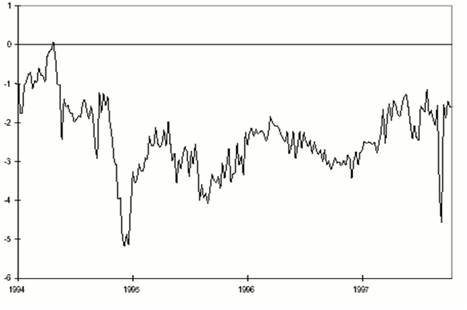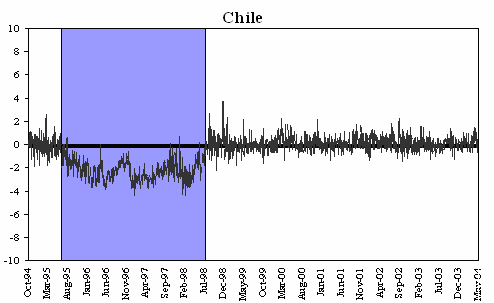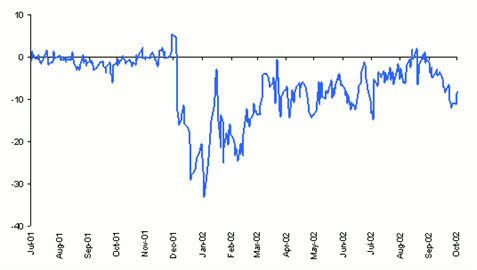Jueves 20 de enero de 2011
Are capital controls effective?
Fuente:
Vox Eu
Autor:
Eduardo Levy Yeyati
“Not only are they ineffective but, in addition, they raise domestic interest rates.” This type of internally inconsistent commentary is not unusual when discussing capital controls – a subject marked with strong beliefs and weak data. Now that the G20 has sanctioned capital controls in Seoul under the umbrella of macro-prudential policies, it is a good time to revisit the subject of controls in a dispassionate way (G20 2010).1
The capital control debate can be broken into two basic questions: (a) How effective are they? and (b) Are they efficient instruments (and if so, when)?�This column addresses the first of these two questions.
The debate about the effectiveness of capital controls – namely, whether or not they influence cross-border flows– has received considerable attention in the economic literature. One area of focus has been the controls on inflows imposed by the Chilean government in the mid 1990s, which has generated a series of empirical works, sometimes with contrasting results (see for example, Edwards 1999, De Gregorio et al. 2000. Edwards and Valdes 2000, and Gallego and Herm�ndez 2003).
Evidence from 1990s Chile
These controls, which took the forms of a one-year unremunerated reserves requirement on capital inflows, were virtually identical to a Tobin tax on cross-border inflows – so much so that back then the Chilean authorities offered the option of an up-front Tobin tax in exchange for the unremunerated reserves requirement to those investors with a stronger preference for liquidity.
Making a convincing case based on a counterfactual analysis of a single case is virtually impossible – the sceptical argument that controls in Chile failed to fend off capitals inflows and revert the real appreciation says nothing about what inflows and appreciation would have been like in the absence of controls.
But there are simple ways to quantify what the capital controls aim to introduce in the first place – that is, a wedge between the local and international rates. One that would allow the central bank to tighten monetary policy counter-cyclically, while avoiding the countervailing offset of new capital flows lured by the widening interest rate differential (alternatively, reducing sterilisation costs).2
One such quantification is offered by De Gregorio et al. (2000). Figure 1 below, extracted from their work, shows how the difference between the (90-day) UF-US dollar forward discount and interest rate differential (that is, the deviation from covered interest rate parity) oscillated during the period of controls between 2% and 3%. This was in line with the value of the equivalent Tobin tax during the period, calculated by the authors in the paper.3 In other words, the rate differential widened proportionally to the strength of the unremunerated reserves requirement.
Figure 1. Chile forward discount vs. interest rate differentials in times of controls

Note: Difference between the 90-day UF-US dollar forward discount and the interest rate differential. Source: De Gregorio et al. (2000).
Another way to gauge the same effect is by comparing prices of identical assets trading domestically and abroad, for example, stocks and American Depository Receipts (ADRs).4 �Assuming expected return arbitrage across markets, the percentage price discount between the (underlying) shares in Santiago and the corresponding ADR in New York (the cross-market premium), can be attributed to transaction costs including, most notably, the 3% Tobin tax, as the international investor demands a compensating 3% yield premium (a 3% price discount) from the stock in Santiago (see Figure 2). That is precisely what is found in the data during the period of controls (shaded), where it can be seen how the ADR premium rises and declines reflecting the intensity of capital inflows.5
Figure 2. Percentage difference of the price of the stock in the domestic market and the corresponding ADR in the NYSE

Source: Levy Yeyati et al. (2009).
The same measure can be readily applied to assess the effect of quantitative limits on capital flows, like those that characterized emerging Asia in the 90s, or, more recently, the ones imposed in the midst of the Argentine crisis in 2002. The latter case provides a stark rebuttal of the common argument that markets always finds the way to circumvent controls.
As can be seen in the Figure, markets do find the way, but at a hefty cost. In the Argentine case, moving capital from Buenos Aires to New York (by purchasing the local stock and selling the ADR, perhaps the most liquid channel for outflows back then) entailed a toll that averaged 20% in the first quarter of 2002, with peaks that exceeded 40% (see Figure 3).
Figure 3. Argentina: The cross-market premium during the 2002 crisis

Note: Percentage difference of the price of the stock in the domestic market and the corresponding ADR in the NYSE. Source: Levy Yeyati et al. (2004).
Argentina, always a rich finance lab, offered yet another experiment in capital controls (both quantitative on outflows, and Tobin-like on inflows) and a new vehicle to measure their effectiveness, i.e. the price difference between Buenos Aires and New York of sovereign dollar bonds that traded simultaneously in both markets. As Figure 4 indicates, this can jump above 5% during episodes of capital flight, and become negative in times of capital repatriation.
Figure 4. Price difference between the dollar discount bond in Buenos Aires and the NYSE

Source: Kiguel and Levy Yeyati (2009)
Conclusions
Are controls effective?
Yes, as they impose a toll on traffic in and out of domestic markets.
How effective?
This will depend on the cost of the toll (and the volume of traffic). For example, a 2% tax will not obtain much more than a 3% cut in the value of local assets (including the local currency); a 10% tax will obtain a proportionally (but probably not linearly) stronger effect. A 2% tax opened to future adjustments (as recently seen in Brazil) should have an effect somewhere in between, as it affects the expectations and should keep the position of short-term speculative investors relatively light.
Given that they are effective, are they efficient?
Probably yes, if the objective is to mitigate the impact of the capital flows that emulate (and usually amplify) global or domestic economic cycles. But, at this point, controls need to be considered as part of a macro-prudential toolkit to prevent asset inflation and overvaluation that is costly to revert in the down cycle. This toolkit should also include sterilised intervention, debt policy (as in sovereign debt de-dollarization), incentives for foreign asset accumulation (as in the relaxation of foreign assets investment limits on pension funds), and micro prudential regulation on financial intermediaries.
The convenience of the capital controls can only be analysed within the optimal macro-prudential mix (the combination of instruments, intensity, and contingent rules) – a complex subject that is already at the centre of the macroeconomic policy debate in the developing world.
References
De Gregorio, Jos�, Sebasti�n Edwards, and Rodrigo O Vald�s (2000), “Controls on Capital Inflows: Do they Work?”, Journal of Development Economics, 63(1):59-83, October.
Edwards, Sebasti�n (1999), “How Effective are Capital Controls?”, Journal of Economic Perspectives, 13(4):65-84, Fall.
Forbes, Kristin J (2007), “One Cost of the Chilean Capital Controls: Increased Financial Constraints for Smaller Traded Firms”, Journal of International Economics, 71(2):294-323, April.
G20 (2010), “The G20 Seoul Summit, Leaders’ Declaration”, 11-12 November.
Gallego, Francisco and Leonardo Hern�ndez (2003), “Microeconomic Effects of Capital Controls: The Chilean Experience During the 1990s”, International Journal of Finance & Economics, 8(3):225-253.
Kiguel, Andrea and Eduardo Levy Yeyati (2009), “Quantifying the effect of a Tobin tax: The case of the Brazilian IOF”, Barclays Capital.
Levy Yeyati, Eduardo, Sergio L Schmukler, and Neeltje Van Horen (2004), “The price of inconvertible deposits: The stock market boom during the Argentine crisis,” Economic Letters, 83(1):7-14.
Levy Yeyati, Eduardo, Sergio Schmukler, and Neeltje Van Horen (2009), “International Financial Integration through the Lens of the Law of One Price”, Journal of Financial Intermediation.
1 In the G20�s own terms:“…in circumstances where countries are facing undue burden of adjustment, policy responses in emerging market economies with adequate reserves and increasingly overvalued flexible exchange rates may also include carefully designed macro-prudential measures.” (G20 2010).
2 It follows that the higher domestic interest rates sometimes highlighted by control skeptics (Forbes 2003) could be seen as a prima facie proof of their effectiveness.
3 The Unidad de Fomento (UF), the prevalente unit of account in Chile at the time, is indexed to the Chilean CPI.
4 American Depository Receipts (ADR) are shares of non-US corporations traded in the US (and denominated in dollars), while the underlying shares trade in the domestic market of the issuer. A depositary receipt is issued by a so-called depositary bank in the US and represents a specific number of underlying shares remaining on deposit in a custodian bank in the issuer’s home market.
5 Note that when, in the third quarter of 1998, contagion from the Asian crises triggered a wave of capital outflows led to the phasing out of unremunerated reserves requirement, the latter were no longer binding.
This article may be reproduced with appropriate attribution.
�
